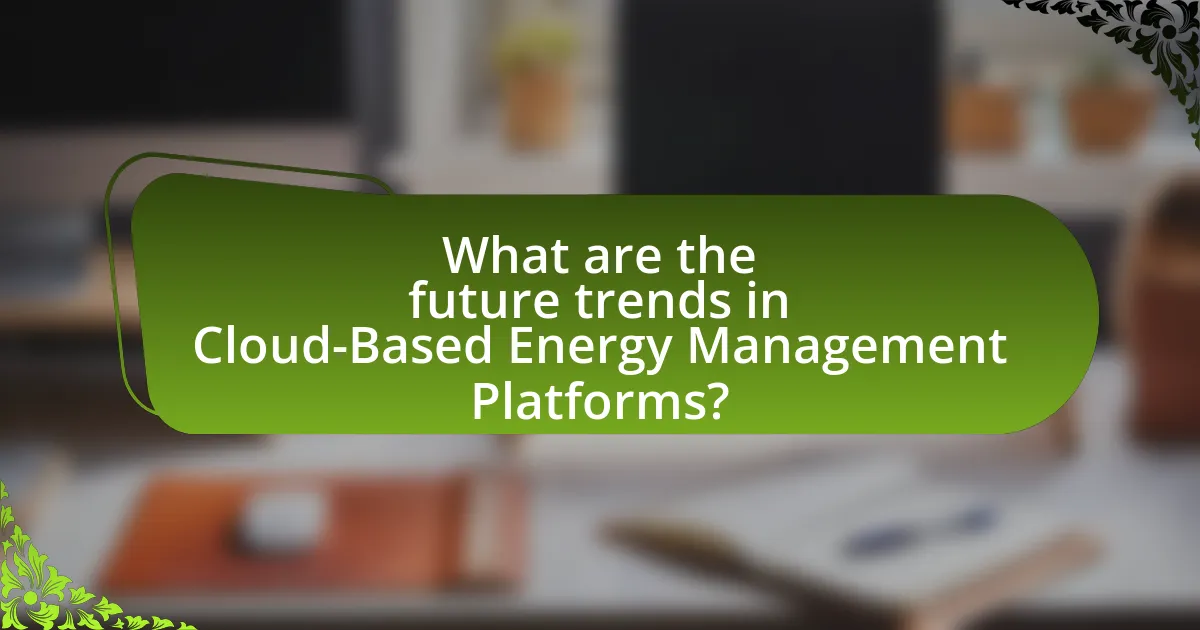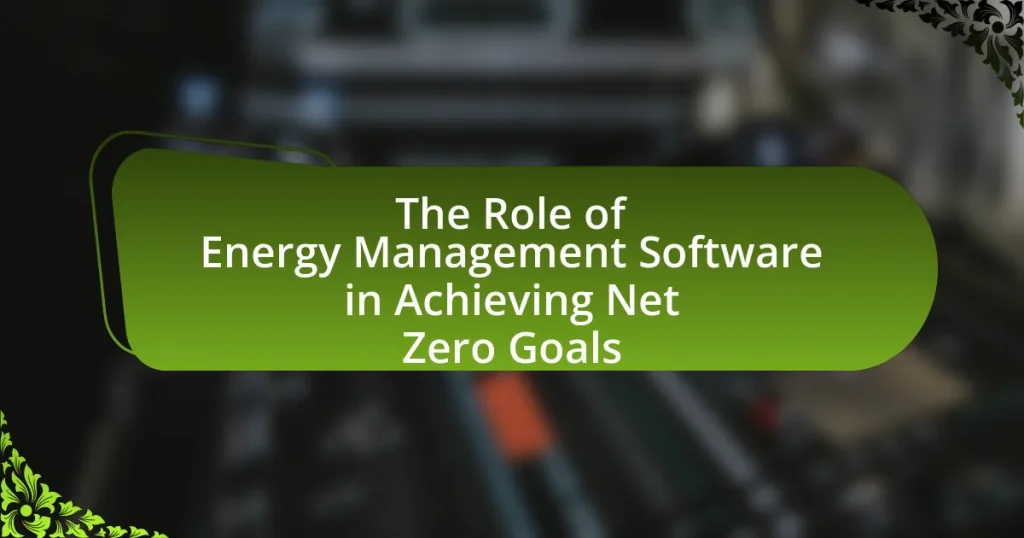Cloud-Based Energy Management Platforms are advanced software solutions that leverage cloud computing to monitor, control, and optimize energy consumption in real-time. These platforms utilize technologies such as IoT devices, big data analytics, and artificial intelligence to enhance operational efficiency, reduce costs, and support sustainability initiatives across various industries. Key features include real-time monitoring, automated reporting, and integration capabilities, which collectively enable organizations to achieve significant energy savings and improve decision-making. The article also addresses the challenges of implementation, future trends in technology, and best practices for successful adoption, highlighting the transformative impact of these platforms on energy management.

What are Cloud-Based Energy Management Platforms?
Cloud-Based Energy Management Platforms are software solutions that utilize cloud computing technology to monitor, control, and optimize energy consumption in real-time. These platforms enable organizations to collect and analyze energy data from various sources, facilitating improved decision-making and operational efficiency. According to a report by Navigant Research, the global market for cloud-based energy management solutions is expected to grow significantly, driven by the increasing demand for energy efficiency and sustainability initiatives.
How do Cloud-Based Energy Management Platforms function?
Cloud-based energy management platforms function by utilizing internet-based software to monitor, analyze, and optimize energy consumption in real-time. These platforms collect data from various energy sources and devices, enabling users to track usage patterns, identify inefficiencies, and implement energy-saving strategies. For instance, according to a report by the International Energy Agency, organizations using cloud-based energy management systems can reduce energy costs by up to 20% through improved data visibility and actionable insights.
What technologies are utilized in Cloud-Based Energy Management Platforms?
Cloud-Based Energy Management Platforms utilize technologies such as Internet of Things (IoT) devices, big data analytics, artificial intelligence (AI), and cloud computing. IoT devices collect real-time energy consumption data, while big data analytics processes this information to identify patterns and optimize energy usage. AI algorithms enhance decision-making by predicting energy demand and automating responses. Cloud computing enables scalable storage and access to data from anywhere, facilitating collaboration and integration across various systems. These technologies collectively improve energy efficiency and reduce operational costs, as evidenced by studies showing up to 30% energy savings in organizations that implement such platforms.
How do these technologies enhance energy management?
Cloud-based energy management platforms enhance energy management by providing real-time data analytics and remote monitoring capabilities. These technologies enable organizations to track energy consumption patterns, identify inefficiencies, and optimize resource allocation. For instance, a study by the U.S. Department of Energy found that implementing cloud-based solutions can lead to energy savings of up to 30% by facilitating better decision-making through data insights. Additionally, these platforms support automated controls and demand response strategies, further improving energy efficiency and reducing operational costs.
What are the key features of Cloud-Based Energy Management Platforms?
Cloud-Based Energy Management Platforms offer several key features that enhance energy efficiency and operational effectiveness. These platforms typically include real-time monitoring and analytics, which allow users to track energy consumption patterns and identify inefficiencies. Additionally, they provide automated reporting tools that simplify compliance with regulatory requirements and facilitate decision-making. Integration capabilities with existing systems and IoT devices enable seamless data exchange, enhancing overall functionality. Furthermore, user-friendly dashboards present complex data in an accessible format, aiding in strategic planning. According to a report by Navigant Research, organizations utilizing cloud-based energy management solutions can achieve energy savings of up to 20% through improved visibility and control over their energy usage.
How do real-time monitoring and analytics contribute to energy efficiency?
Real-time monitoring and analytics significantly enhance energy efficiency by providing immediate insights into energy consumption patterns and operational performance. These tools enable organizations to identify inefficiencies, optimize energy use, and implement corrective actions swiftly. For instance, a study by the U.S. Department of Energy found that real-time energy monitoring can lead to energy savings of 10-30% in commercial buildings by allowing for timely adjustments based on actual usage data. This data-driven approach empowers businesses to make informed decisions, reduce waste, and ultimately lower energy costs.
What role does automation play in Cloud-Based Energy Management?
Automation plays a crucial role in Cloud-Based Energy Management by enabling real-time monitoring and control of energy consumption. This capability allows organizations to optimize energy usage, reduce costs, and enhance operational efficiency. For instance, automated systems can analyze energy data and adjust settings dynamically, leading to a reported 10-30% reduction in energy costs, as evidenced by various case studies in the industry. Additionally, automation facilitates predictive maintenance, ensuring that energy systems operate at peak performance, which further contributes to sustainability goals and compliance with regulatory standards.
What advantages do Cloud-Based Energy Management Platforms provide?
Cloud-Based Energy Management Platforms provide enhanced accessibility, scalability, and real-time data analytics. These platforms allow users to monitor and manage energy consumption from any location, facilitating timely decision-making. The scalability of cloud solutions enables organizations to adjust their energy management systems according to their needs without significant infrastructure investments. Real-time data analytics empower users to identify inefficiencies and optimize energy usage, leading to cost savings and reduced environmental impact. According to a report by the International Energy Agency, organizations utilizing cloud-based solutions can achieve energy savings of up to 20% through improved monitoring and management capabilities.
How do these platforms reduce operational costs?
Cloud-based energy management platforms reduce operational costs by optimizing energy consumption and improving efficiency. These platforms utilize real-time data analytics to identify energy usage patterns, enabling organizations to make informed decisions that lower energy waste. For instance, a study by the U.S. Department of Energy found that implementing energy management systems can lead to energy savings of 10% to 30%. Additionally, these platforms often automate processes, reducing the need for manual intervention and minimizing labor costs. By integrating renewable energy sources and demand response strategies, organizations can further decrease reliance on expensive peak energy rates, leading to significant cost reductions.
In what ways do they improve sustainability efforts?
Cloud-based energy management platforms improve sustainability efforts by optimizing energy consumption and reducing waste. These platforms utilize real-time data analytics to monitor energy usage patterns, enabling organizations to identify inefficiencies and implement targeted strategies for energy reduction. For instance, a study by the International Energy Agency found that implementing energy management systems can lead to energy savings of 10-30%. Additionally, these platforms facilitate the integration of renewable energy sources, further decreasing reliance on fossil fuels and lowering carbon emissions. By providing actionable insights and fostering a culture of energy efficiency, cloud-based energy management platforms significantly contribute to enhanced sustainability outcomes.

How do Cloud-Based Energy Management Platforms impact various industries?
Cloud-Based Energy Management Platforms significantly enhance operational efficiency across various industries by providing real-time data analytics and energy monitoring capabilities. These platforms enable organizations to optimize energy consumption, reduce costs, and improve sustainability efforts. For instance, in the manufacturing sector, companies using cloud-based solutions have reported energy savings of up to 20% through better demand forecasting and load management. In the commercial real estate industry, energy management platforms facilitate the integration of renewable energy sources, leading to a reduction in carbon footprints and compliance with regulatory standards. Additionally, the retail sector benefits from these platforms by analyzing energy usage patterns, which helps in making informed decisions about energy procurement and usage strategies. Overall, the impact of Cloud-Based Energy Management Platforms is evident in their ability to drive efficiency, cost savings, and sustainability across diverse industries.
Which sectors benefit the most from Cloud-Based Energy Management Platforms?
The sectors that benefit the most from Cloud-Based Energy Management Platforms are commercial real estate, manufacturing, and utilities. Commercial real estate utilizes these platforms to optimize energy consumption and reduce operational costs, leading to significant savings; for instance, studies show that energy management can reduce energy costs by up to 30%. Manufacturing sectors leverage cloud-based solutions to monitor and control energy usage in real-time, enhancing efficiency and sustainability, with reports indicating that energy management systems can improve energy efficiency by 10-20%. Utilities benefit by integrating these platforms to manage demand response and grid stability, which can lead to improved service reliability and reduced peak load pressures.
What specific use cases exist in the commercial sector?
Specific use cases in the commercial sector for cloud-based energy management platforms include real-time energy monitoring, predictive maintenance, and demand response optimization. Real-time energy monitoring allows businesses to track energy consumption patterns, enabling them to identify inefficiencies and reduce costs. Predictive maintenance utilizes data analytics to forecast equipment failures, minimizing downtime and maintenance expenses. Demand response optimization helps companies adjust their energy usage during peak periods, leading to cost savings and improved grid stability. These use cases demonstrate the practical applications of cloud-based energy management in enhancing operational efficiency and sustainability in commercial settings.
How are industrial applications enhanced by these platforms?
Industrial applications are enhanced by cloud-based energy management platforms through improved data analytics, real-time monitoring, and increased operational efficiency. These platforms enable industries to collect and analyze vast amounts of energy consumption data, allowing for informed decision-making and optimization of energy use. For instance, a study by the International Energy Agency found that implementing cloud-based solutions can lead to energy savings of up to 20% in industrial settings. Additionally, real-time monitoring capabilities facilitate immediate responses to energy usage anomalies, further enhancing operational performance and reducing costs.
What challenges do organizations face when implementing Cloud-Based Energy Management Platforms?
Organizations face several challenges when implementing Cloud-Based Energy Management Platforms, including data security concerns, integration with existing systems, and user adoption issues. Data security is a primary concern, as organizations must ensure that sensitive energy data is protected from breaches; a report by Cybersecurity Ventures predicts that cybercrime will cost the world $10.5 trillion annually by 2025, highlighting the importance of robust security measures. Integration challenges arise when organizations attempt to connect new cloud platforms with legacy systems, which can lead to compatibility issues and increased costs; according to a survey by Gartner, 70% of organizations face integration difficulties during cloud adoption. Lastly, user adoption issues can hinder the effectiveness of these platforms, as employees may resist changes to their workflows; research from McKinsey indicates that 70% of change initiatives fail due to lack of employee engagement.
How can data security concerns be addressed?
Data security concerns can be addressed through the implementation of robust encryption methods, regular security audits, and strict access controls. Encryption protects sensitive data by converting it into a format that can only be read by authorized users, thereby mitigating risks of unauthorized access. Regular security audits help identify vulnerabilities in the system, allowing organizations to proactively address potential threats. Strict access controls ensure that only authorized personnel can access sensitive information, reducing the likelihood of data breaches. According to a report by the Ponemon Institute, organizations that implement these measures can reduce the risk of data breaches by up to 50%.
What are the common integration issues with existing systems?
Common integration issues with existing systems include data silos, compatibility challenges, and legacy system constraints. Data silos occur when information is isolated within different departments or systems, preventing seamless data flow and collaboration. Compatibility challenges arise when new cloud-based platforms do not align with the existing software or hardware, leading to integration difficulties. Legacy system constraints refer to outdated technologies that may not support modern integration methods, hindering the adoption of new solutions. These issues can significantly impact the efficiency and effectiveness of energy management processes in organizations.

What are the future trends in Cloud-Based Energy Management Platforms?
Future trends in Cloud-Based Energy Management Platforms include increased integration of artificial intelligence for predictive analytics, enhanced data security measures, and the adoption of Internet of Things (IoT) devices for real-time monitoring. The integration of AI allows for more accurate forecasting of energy consumption patterns, which can lead to optimized energy usage and cost savings. Enhanced data security is becoming critical as more sensitive information is stored in the cloud, prompting platforms to adopt advanced encryption and compliance with regulations like GDPR. Additionally, the proliferation of IoT devices enables continuous data collection and analysis, facilitating smarter energy management decisions. According to a report by MarketsandMarkets, the global cloud-based energy management market is projected to grow from $4.5 billion in 2020 to $11.5 billion by 2025, reflecting the increasing reliance on these technologies.
How is artificial intelligence shaping the future of energy management?
Artificial intelligence is transforming energy management by enabling predictive analytics, optimizing energy consumption, and enhancing grid reliability. AI algorithms analyze vast amounts of data from various sources, allowing for real-time decision-making that improves efficiency and reduces costs. For instance, a study by the International Energy Agency found that AI could help reduce energy consumption in buildings by up to 30% through smart automation and demand response strategies. Additionally, AI-driven platforms can forecast energy demand and supply fluctuations, facilitating better integration of renewable energy sources into the grid. This capability not only supports sustainability goals but also enhances the resilience of energy systems against disruptions.
What advancements in predictive analytics can be expected?
Advancements in predictive analytics will include enhanced machine learning algorithms, improved data integration capabilities, and real-time analytics. Enhanced machine learning algorithms will enable more accurate forecasting by analyzing larger datasets and identifying complex patterns. Improved data integration capabilities will allow for seamless aggregation of data from various sources, leading to more comprehensive insights. Real-time analytics will facilitate immediate decision-making, allowing organizations to respond swiftly to changing conditions. These advancements are supported by the increasing availability of cloud computing resources, which provide the necessary infrastructure for processing and analyzing vast amounts of data efficiently.
How will IoT integration evolve in energy management solutions?
IoT integration in energy management solutions will evolve through enhanced connectivity, real-time data analytics, and automation. As more devices become interconnected, energy management systems will leverage IoT to gather and analyze data from various sources, enabling more precise energy consumption monitoring and optimization. For instance, a report by McKinsey indicates that IoT applications in energy management could reduce energy costs by up to 30% through improved efficiency and predictive maintenance. This evolution will also facilitate the integration of renewable energy sources, allowing for smarter grid management and demand response strategies.
What best practices should organizations follow when adopting Cloud-Based Energy Management Platforms?
Organizations should prioritize data security and compliance when adopting Cloud-Based Energy Management Platforms. Ensuring robust security measures, such as encryption and access controls, protects sensitive energy data from breaches. Additionally, organizations must comply with relevant regulations, such as GDPR or CCPA, to avoid legal repercussions.
Furthermore, organizations should conduct thorough vendor assessments to select a reliable platform that meets their specific energy management needs. This includes evaluating the platform’s scalability, integration capabilities with existing systems, and user support services.
Training employees on the platform’s functionalities is also essential, as it enhances user adoption and maximizes the platform’s benefits. According to a study by the International Energy Agency, organizations that invest in training see a 20% increase in energy efficiency outcomes.
Lastly, organizations should regularly review and analyze energy data to identify trends and optimize energy usage continuously. This practice not only improves operational efficiency but also contributes to sustainability goals.
How can organizations ensure successful implementation and user adoption?
Organizations can ensure successful implementation and user adoption by engaging stakeholders early in the process and providing comprehensive training. Engaging stakeholders, including employees and management, fosters a sense of ownership and encourages feedback, which can lead to a smoother transition. Comprehensive training equips users with the necessary skills and knowledge to effectively utilize the new system, thereby increasing confidence and reducing resistance. According to a study by Prosci, organizations that actively involve employees in change initiatives are 6 times more likely to achieve their objectives.
What strategies can be employed for continuous improvement in energy management?
Strategies for continuous improvement in energy management include implementing data analytics, adopting energy-efficient technologies, and fostering employee engagement. Data analytics enables organizations to monitor energy consumption patterns, identify inefficiencies, and make informed decisions based on real-time data. For instance, a study by the U.S. Department of Energy found that organizations using data analytics can reduce energy consumption by up to 20%.
Adopting energy-efficient technologies, such as LED lighting and smart HVAC systems, further enhances energy management by reducing overall energy usage and operational costs. According to the Energy Star program, businesses can save 30% on energy bills by upgrading to energy-efficient equipment.
Fostering employee engagement through training and awareness programs encourages staff to adopt energy-saving practices, leading to a culture of sustainability. Research from the Carbon Trust indicates that organizations with engaged employees can achieve energy savings of 10-15%. These strategies collectively contribute to a robust framework for continuous improvement in energy management.



